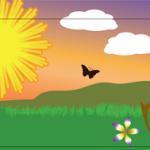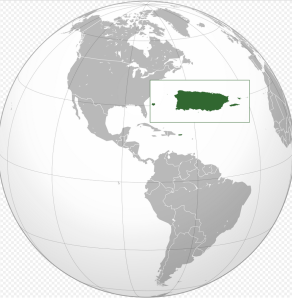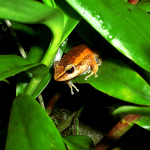Capítulo 5: Las vacaciones
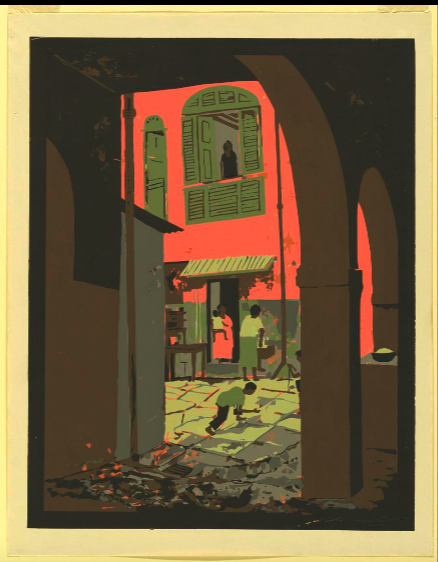
Niños jugando, 1953 (Rafael Tufiño)
Sobre el artista: Rafael Tufiño was a printmaker, painter, and muralist. He is known as the painter of the people. He was part of a group of artists who worked to develop a new identity for Puerto Rico. His work portrays Puerto Rico´s underrepresented agricultural workers, and he is best known for his illustrations of plenas (Puerto Rican folk songs).
Learning Objectives
At the end of this chapter, students will be able to perform the following tasks in Spanish:
- I can discuss and plan a vacation
- I can talk about the seasons and the weather
- I can talk about how I feel
- I can describe what I am doing at the moment
Vocabulario
Travel and vacation / Months of the year / Seasons and Weather
Pronunciación
The consonants H & CH
Mosaicos culturales
El concepto del tiempo y la puntualidad
Estructuras gramaticales
5.1 The verb ESTAR
5.2 The Present Progressive Tense
5.3 Ser vs. Estar
Escritura
Cultura
País: Puerto Rico
Música: Marc Anthony
Personalidad: Lin-Manuel Miranda
Lectura
Lugares favoritos para visitar
Vocabulario: Las vacaciones
| Viaje
El folleto |
Trips
brochure |
|---|
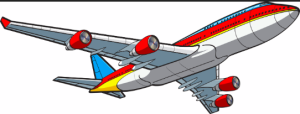 |
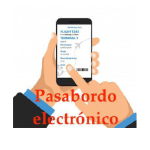 |
|---|---|
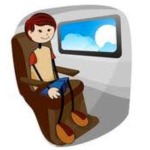 |
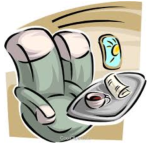 El asiento del pasillo El asiento del medio Middle seat |
| En el avión
El (la) auxiliar de vuelo |
In the plane flight attendant life jacket luggage compartment row lavatory oxygen mask tray table passenger pilot emergency exit to fasten the seatbelt |
|---|

| El hotel
El ascensor |
Hotel
elevator |
|---|
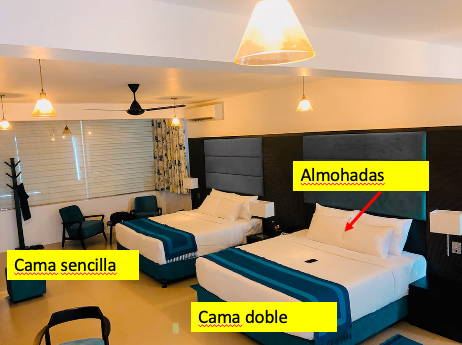
| Verbos
Abordar |
Verbs
to board |
|---|
Adjectives to describe emotions and temporary condition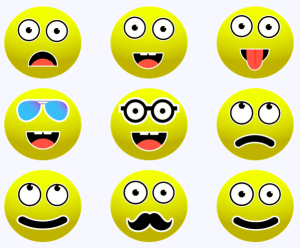
| Abierto (a) | Open | Equivocado (a) | Wrong |
|---|---|---|---|
| Aburrido (a) | Bored | Feliz | Happy |
| Alegre | Happy | Limpio (a) | Clean |
| Avergonzado (a) | Embarrassed | Listo (a) | Ready |
| Cansado (a) | Tired | Nervioso (a) | Nervous |
| Cerrado (a) | Closed | Ocupado (a) | Busy |
| Cómodo (a) | Comfortable | Ordenado (a) | Organized |
| Confundido (a) | Confused | Preocupado (a) por | Worried about |
| Contento (a) | Content, Happy | Seguro (a) | Sure, Safe |
| Desordenado (a) | Messy, Disorganized | Sucio (a) | Dirty |
| Enamorado (a) de | In love with | Triste | Sad |
| Enojado (a) | Angry | Tranquilo (a) | Peaceful, Quiet, Calm |
ACTIVIDAD # 1
Escoger. Choose the appropriate answer for each sentence.
1. La __________ sirve los refrescos en el avión.
a. huésped b. gerente c. auxiliar de vuelo
2. Me gusta viajar en ___________.
a. hacer las maletas b. primera clase c. acampar
3. Siempre necesitas un ________ para viajar a otro (another) país.
a. maletas b. pasaporte c. llave
4. El ___________ nos ayuda con las maletas.
a. el auxiliar de vuelo b. el agente de viajes c. el botones
5. Abrimos la habitación del hotel con una __________.
a. llave b. pasaporte c. maleta
¡Inténtalo!
ACTIVIDAD # 2
De viaje. Using the letters given to the right, indicate if you do the following activities before, during, or after a trip.
A = Antes del viaje B = Durante el viaje C = Después del viaje
___ nadar en la alberca (piscina) ___ hacer las maletas
___ comprar los boletos ___ lavar la ropa
___ abordar el avión ___ hospedarse
___ mostrar el pasaporte ___ comprar recuerdos
___ hablar de tus experiencias ___ desempacar
ACTIVIDAD # 3
ACTIVIDAD # 4
Mis preferencias. ¿Qué te gusta y NO te gusta cuando estás de vacaciones?
Pick your three favorite things from the list below, and write a sentence for each explaining why you like each activity. Then pick two that you don’t like and do the same.
| comer bien explorar la ciudad ir a museos nadar en la piscina leer ir a la playa tomar fotos hablar con personas ir de compras dormir tomar el sol visitar sitios históricos ir a un evento deportivo chequear Redes Sociales salir de copas comprar recuerdos |
|---|
+ Me gusta
- _________________________.
- ________________________.
- ________________________.
– No me gusta
- _________________________.
- _________________________.
ACTIVIDAD # 5 Write-Pair-Share
Travel Preferences. Paso 1. Go through the following list of statements and write SÍ if they apply to you or NO if they don´t.
Paso 2. Change the statements to questions (hint: change the underlined verbs), and ask your compañero (a), and write their answers. Be prepared to share with the class.
| Statements | YO
Sí /No |
Mi compañero (a) |
|---|---|---|
| Tengo mucho miedo de viajar en avión. | ||
| Siempre compro los boletos en mi teléfono celular. | ||
| A mí no me gusta viajar. Me gusta estar en casa. | ||
| Pienso que viajar es muy divertido. | ||
| En un avión, prefiero el asiento de ventanilla. | ||
| Me gusta mucho hacer un crucero (cruise). | ||
| Tengo pasaporte. | ||
| En un hotel, prefiero una habitación frente a la piscina. | ||
| Cuando viajo, me gusta llevar mi almohada (pillow). | ||
| Te gusta viajar con tu familia. | ||
| Prefiero viajar en Navidad. | ||
| Me gustan las camas dobles. | ||
| El verano (Summer) es mi estación favorita. |
ACTIVIDAD # 6
¡Vamos a hablar! With a partner, take turns asking and answering the following questions:
ESTUDIANTE A
1. ¿Prefieres viajar por avión, por tren o por carro? ¿Por qué?
2. En un avión, ¿prefieres el asiento de ventanilla o el asiento del pasillo? ¿por qué?
3. ¿Te gusta viajar o prefieres quedarte en casa (stay home)?
4. ¿Tienes miedo cuando vuelas en un avión?
5. ¿Cuál es tu lugar (place) favorito para ir de vacaciones?
ESTUDIANTE B
1. ¿Te gusta viajar?
2. ¿Llevas muchas maletas cuando viajas? ¿Qué llevas?
3. ¿Te gustan los viajes exóticos o prefieres las ciudades grandes?
4. ¿Cuál es tu lugar favorito para ir de vacaciones?
5. Cuando vuelas, ¿Duermes o prefieres mirar por la ventana?
ACTIVIDAD # 7
Mi lugar favorito. Choose a vacation destination from the list given. If you are not familiar with these places, do some research and then WRITE a few sentences describing why you chose that destination and how it fits with your personality and interests.
| Playas | Ciudades | Naturaleza | Sitios Arqueológicos |
|---|---|---|---|
| Cabo San Lucas | Madrid | Parque Manuel Antonio | Machu Picchu |
| La playa Cristal | Buenos Aires | Las Islas Galápagos | Tikal |
| Punta del Este | El D.F. México | Lago Titicaca | Teotihuacán |
| Varadero | Cartagena | Las cataratas de Iguazú | Copán |
Los meses y las estaciones del año

el invierno: diciembre, enero, febrero |

la primavera: marzo, abril, mayo |
|---|---|

el verano: junio, julio, agosto |

el otoño: septiembre, octubre, noviembre |
ACTIVIDAD # 1
¿Verano, otoño, invierno o primavera? Write down which season it would be in the following countries during the months given.
Ejemplo: En Uruguay en enero es verano.
En Arizona en julio es _____________________.
En Argentina en agosto es __________________.
En México en octubre es ___________________.
En Alaska en diciembre es __________________.
En España en enero es ____________________.
En Chile en diciembre es ___________________.
¡Inténtalo!
ACTIVIDAD # 2
¿En qué estación. . .? Determine which season corresponds best for the following activities.
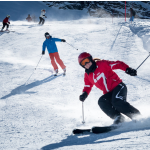
1. ¿Te gusta esquiar en _________? |
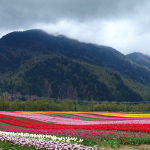
2. Me gusta ver las flores en_________ |
|---|---|
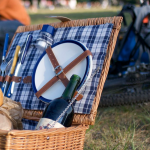
3. Me gusta hacer pícnics en _________ |
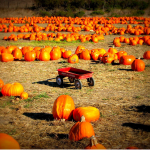
4. Yo compro calabazas en __________ |

5. Me gusta ver las hojas (leaves) en _________ |
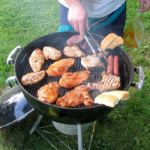
6. Yo cocino en la parrilla en _________ |
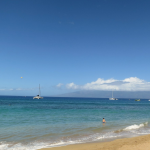
7. Me gusta nadar en _________ |
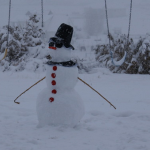
8. Me gusta hacer muñecos de nieve en _________ |
Las fechas y el tiempo
A. Las fechas. Dates in Spanish are given by day/month. For example, 12/5 is May 12 and not Dec. 5. For years, the entire number is spoken. For example, 1,998 is mil novecientos noventa y ocho and not 19-98 (except in Argentina).
¿Cuál es la fecha de hoy?
¿Qué fecha es hoy? What is today’s date?
(Hoy) Es el primero de septiembre (Today is) It’s the first of September.
(Hoy) Es el trece de mayo (Today is) It’s May thirteen.
ACTIVIDAD # 1 Las fechas
Paso 1. Exprese estas fechas en español y en qué estación caen (do they fall).
Ejemplo: May 13, 1966 —— Es el trece de mayo de mil novecientos sesenta y seis. Cae (It falls) en la primavera.
- July 4, 1776
- May 5, 1862
- October 12, 1492
- September 16, 1810
- January *1, 1959
- September 11, 1973
* Only for FIRST, we use the ordinal number EL PRIMERO
Paso 2. ¡Investígalo! (Research it!) Pick a date listed above that you don´t know and look it up online. What is its significance?
ACTIVIDAD # 2
Días feriados (holidays). Take turns with a partner, saying out loud when
we celebrate the following holidays.
Ejemplo: La Navidad —–Celebramos la Navidad el 25 de diciembre.
- El Día de Año Nuevo (New Year’s Day)
- El Día de Acción de Gracias (Thanksgiving)
- El Día de la Madre
- El Día del niño
- Tu cumpleaños
ACTIVIDAD # 3
Encuesta: ¿Cuándo es tu cumpleaños? Y ¿En qué estación cae (it falls)?
Go around the room and interview five (5) to six (6) of your compañer@s about their birthday and in which season it falls. Write the answers in the chart.
Ejemplo:
Estudiante 1: ¿Cuándo es tu cumpleaños?
Estudiante 2: Mi cumpleaños es el ____ de ________.
(día) (mes)
Estudiante 1: ¿En qué estación cae?
Estudiante 2: Cae en ___________.
(estación)
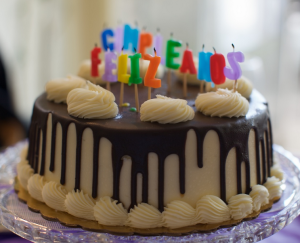
| Nombre de tu compañer@ | Día | Mes | Estación |
|---|---|---|---|
| de enero | |||
| de febrero | |||
| de marzo | |||
| de abril | |||
| de mayo | |||
| de junio | |||
| de julio | |||
| de agosto | |||
| de septiembre | |||
| de octubre | |||
| de noviembre | |||
| de diciembre |
ACTIVIDAD # 4
Las fiestas hispanas (Holidays). Work with a partner and research two important Hispanic holidays and/or festivals. Write the name of the event, the date, and the country in Spanish. Then, write a brief description in English. You may watch this short video to learn about El Día de los Muertos (Day of the Dead) celebration in Mexico.
| Fiesta:
Fecha: País: |
Descripción:
|
|---|
| Fiesta:
Fecha: País: |
Descripción:
|
|---|
B. EL TIEMPO. ¿Qué tiempo hace? (How is the weather?)
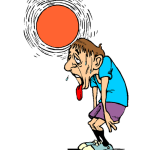
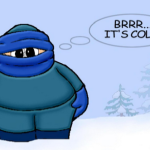
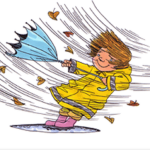
HACE (mucho) calor HACE (mucho) frío HACE viento
It´s (very) hot It´s (very) cold It´s windy
HACE sol/ESTÁ soleado HACE mal tiempo HACE buen tiempo
It´s sunny It´s bad weather It´s good weather
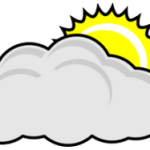
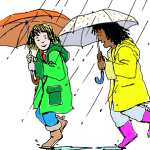
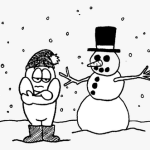
ESTÁ nublado ESTÁ lloviendo ESTÁ nevando
It´s cloudy LLUEVE NIEVA
It´s raining It´s snowing
HACE fresco It´s cool
HAY niebla It´s foggy
TRUENA To thunder
ACTIVIDAD # 1
El clima de tu ciudad. Describe the weather in your city using weather expressions.
- ¿Qué tiempo hace hoy?
- ¿Qué tiempo va a hacer mañana?
- ¿Qué tiempo hace en el verano?
- ¿Qué tiempo hace en el invierno?
- ¿Qué tiempo hace en la primavera?
ACTIVIDAD # 2
ACTIVIDAD # 3
Visit this link for an interactive practice with seasons and weather expressions.
ACTIVIDAD # 4
El tiempo y las actividades. Write some sentences, indicating what you do according to the weather. You need to conjugate the verbs.
Ejemplo: Cuando llueve ME GUSTA leer. Cuando llueve JUEGO en la lluvia.
| cuando nieva cuando hace calor cuando hace frío cuando hace mal tiempo cuando llueve cuando hace viento |
+ | (no) | + | jugar videojuegos ir al gimnasio leer trabajar o estudiar hacer la tarea gustar + other activity jugar al baloncesto/ fútbol salir de casa almorzar afuera manejar |
|---|
- _________________________________.
- _________________________________.
- _________________________________.
- _________________________________.
- _________________________________.
ACTIVIDAD # 5
¡Vamos a hablar! With a partner, take turns asking and answering these questions.
ESTUDIANTE A
- ¿Qué fecha es hoy?
- ¿Cuál es tu estación favorita? Y ¿Por qué?
- ¿Cuál es tu día feriado (holiday) favorito?
- ¿Cuándo es tu cumpleaños?
- ¿Cómo te gusta viajar, por avión, carro o tren? Y ¿Por qué?
- ¿Adónde piensas ir en tus próximas vacaciones?
ESTUDIANTE B
- ¿Qué tiempo hace hoy?
- ¿Cuál es tu estación favorita? Y ¿Por qué?
- ¿Cuál es tu día feriado (holiday) favorito?
- ¿Cuándo es tu cumpleaños?
- Cuando haces un viaje, ¿Qué te gusta hacer (to do) y ver (to see)?
- Cuando viajas, ¿Llevas muchas maletas?
Pronunciación
The consonants H & CH
| Pronunciación de la letra H In Spanish, the letter H is silent. It is a letter for which there is no corresponding sound.it sounds like the h in the English word hit.Listen to your instructor and repeat the following words and phrases:hola hombre hacer ahora hija historia hamburguesa habitación almohadaAhora hace mucho calor en mi habitación. Mi hijo Héctor come muchas hamburguesas. |
|---|
| Pronunciación de la letra CH
In the sequence CH, the letters c and h combine to create the sound of ch, pronounced the same as in the English word “church”. Listen to your instructor and repeat the following words and phrases:
mucho chica chocolate escuchar enchiladas La chica quiere chequear sus ocho maletas. A mí me gusta mucho el chocolate y las enchiladas |
|---|
Mosaicos culturales: El concepto del tiempo y la puntualidad
The concept of “punctuality” in Spanish-speaking countries.
| In Spain and many countries in Latin America, the concept of punctuality is considered more “relaxed,” especially when it comes to family gatherings or social events. People don’t mind arriving late to a social event or a party. Arriving early or on time is often considered unnecessary. This is due to the much more relaxing approach to timing and punctuality. People may set up a time on an invitation just for the formality of it, but showing up a few hours after the time requested on the invitation is actually “expected.” People prefer to stay longer and extend the time of the gatherings or parties. This is why there is never an ending time on an invitation, just the “starting” time. |
|---|
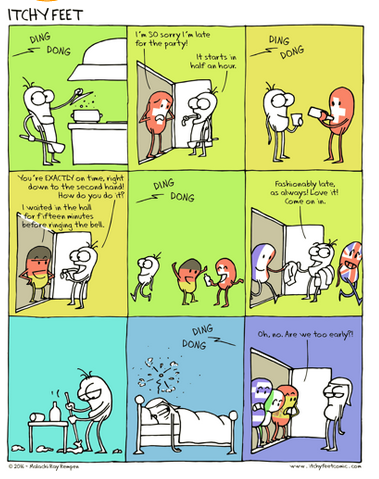
Y ahora ustedes. . .
- ¿Te gusta llegar temprano o tarde a las fiestas?
- ¿Eres puntual? ¿Siempre? ¿Cuándo?
5.1 Gramática: The verb ESTAR (to be)
| Singular | Plural | ||
|---|---|---|---|
| Yo | estoy | Nosotros (as) | estamos |
| Tú | estás | Vosotros (as) | estáis |
| Él, Ella, Usted | está | Ellos, Ellas, Ustedes | están |
The following are the most common uses of the verb ESTAR (To be):
- Location = Nosotros estamos en la universidad (We are at the university)
- Conditions (temporary) = Estoy cansado / cansada (I am tired)
- Emotions = ¿Estás contento / contenta? (Are you happy?)
A. Prepositions And Adverbs To Describe The Location of People or Things
| al lado de | next to | delante de | in front of |
|---|---|---|---|
| a la derecha de | to the right of | detrás de | behind |
| a la izquierda de | to the left of | en | in; on |
| al sur de |
to the south of |
al norte de |
to the north of |
| allá | over there | encima de | on top of |
| allí | there | entre | between |
| aquí / acá | here | en medio de | between |
| arriba de | on top of; above | lejos de | far from |
| cerca de | near | sin | without |
| debajo de | below | sobre | on; over |
Ejemplos: La profesora está delante de la clase.
The professor is in front of the class.
El restaurante está cerca de la universidad.
The restaurant is near the university.
Note: It is common to use the verb QUEDAR to refer to the location of people or things.
El restaurante QUEDA cerca de aquí. ¿Dónde QUEDA la farmacia?
The restaurant is close to here. Where is the pharmacy?
ACTIVIDAD # 1
Location. Write sentences with the verb ESTAR according to each person or place.
- Marta / en la casa. _________________________________.
- Los estudiantes / en la clase. __________________________.
- Yo / en el trabajo (work place). _________________________.
- Puerto Vallarta / México. _____________________________.
- ¿Dónde / la librería? ________________________________.
ACTIVIDAD # 2
¡Ahí no está! (It is not there!) Look at the image and pay close attention to the position of each of the objects. All the statements below are incorrect. Rewrite each sentence with the correct preposition.

- La computadora está al lado del escritorio. ____________________.
- El teléfono está encima de la lámpara. _______________________.
- La silla está detrás del escritorio. __________________________.
- La botella (bottle) de agua está lejos del teléfono._________________.
- El espejo (mirror) está debajo del escritorio. ____________________.
- La lámpara (lamp) está sobre la silla. _________________________.
- La pluma está entre la computadora y el teléfono._________________.
¡Inténtalo!
B. ESTAR with Adjectives that describe emotions and temporary conditions
They need to agree with nouns (masculine and feminine)
| Abierto (a) | Open | Equivocado (a) | Wrong |
|---|---|---|---|
| Aburrido (a) | Bored | Feliz | Happy |
| Alegre | Happy | Limpio (a) | Clean |
| Avergonzado (a) | Embarrassed | Listo (a) | Ready |
| Cansado (a) | Tired | Nervioso (a) | Nervous |
| Cerrado (a) | Closed | Ocupado (a) | Busy |
| Cómodo (a) | Comfortable | Ordenado (a) | Organized |
| Confundido (a) | Confused | Orgulloso (a) |
Proud |
| Contento (a) | Content, Happy | Preocupado (a) por | Worried about |
| Desordenado (a) | Messy, Disorganized | Seguro (a) | Sure, Safe |
| Emocionado (a) | Excited | Sucio (a) | Dirty |
| Enamorado (a) de | In love with | Triste | Sad |
| Enojado (a) / enfadado (a) |
Angry | Tranquilo (a) | Peaceful, Quiet, Calm |
(Note: this also appears in the vocabulary section)
NOTA: Two common expressions that you can use with ESTAR to express your mood is ESTAR de buen humor (to be in a good mood) and ESTAR de mal humor (to be in a bad mood).
ACTIVIDAD # 1
Opuestos. Select from Column B the opposite adjective of Column A.
A B
- Nuevo ___ sucio
- Abierto ___ feo
- Contento ___ desordenado
- Limpio ___ viejo
- Cómodo ___ cerrado
- Bueno ___ intranquilo
- Ordenado ___ pobre
- Tranquilo ___ triste
- Rico ___ incómodo
- Bonito ___ malo
¡Inténtalo!
ACTIVIDAD # 2
Describir. Describe these people and things. ESTAR + adjectives
enamorados triste contento limpia nerviosa aburrido sucia
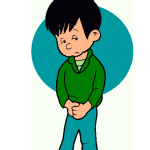 El niño ___________.
El niño ___________.
 Pepe y Lucia___________.
Pepe y Lucia___________.
 La chica ______________.
La chica ______________.
 La señora__________.
La señora__________.
 La ropa___________.
La ropa___________.
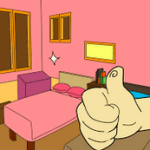 La habitación __________.
La habitación __________.
ACTIVITY # 3
Entrevista: ¿Cómo estás? With a compañero/a, take turns asking and answering the following questions, and follow the example.
Ejemplo: E1: Cuando tienes mucho trabajo, ¿cómo estás?
E2: Cuando TENGO mucho trabajo, ESTOY estresada.
- Los lunes por la mañana, ¿cómo estás?
- Los viernes por la noche, ¿cómo estás?
- Cuando tienes un quiz, ¿cómo estás?
- Cuando no entiendes español, ¿cómo estás?
- Cuando estás con tu familia, ¿cómo estás?
- Cuando llueve, ¿cómo estás?
- Cuando sacas (you get) una A en tu quiz de español, ¿cómo estás?
- Antes de una cita (before a date), ¿cómo estás?
- Cuando no duermes bien, ¿cómo estás?
ACTIVIDAD # 4
¿Qué tipo de música escuchas? Write down the type of music you listen to when you feel the following ways:
Ejemplo: ¿Qué tipo de música escuchas cuando estás triste?
CUANDO ESTOY TRISTE. . . Escucho música latina.
CUANDO ESTOY. . . Escucho.. .
| alternativa | boleros | clásica | gospel | blues |
|---|---|---|---|---|
| rock | jazz | bachata | rock pesado | punk |
| country | R & B | techno | folklórica | reggaeton |
| salsa | hip hop | pop | banda | mariachi |
- Contento/a
- Frustrado/a
- Enamorado/a
- Triste
5.2 Gramática: The Present Progressive Tense
- The progressive is used to express actions that are in progress or ongoing. It is not used for future actions.
- It is formed by combining the verb “to be” (ESTAR) with the present participle (-ing form of a verb).
Estoy hablando español. (I am speaking Spanish.)
- For the -AR verbs, add -ANDO to the stem of the verb.
- For -ER and -IR verbs, add -IENDO to the stem of the verb.
| -AR | -ER | -IR |
|---|---|---|
| Hablando | Comiendo | Escribiendo |
| Speaking | Eating | Writing |
There are a few irregular gerunds in Spanish:
| Verb | Gerund |
|---|---|
| Leer | Leyendo / Reading |
| Creer | Creyendo / Believing |
| Pedir | Pidiendo / Asking for; Ordering |
| Servir | Sirviendo / Serving |
| Dormir | Durmiendo / Sleeping |
| Decir | Diciendo / Saying; Telling |
¡¡¡ATENCIÓN !!! To ask what someone is doing…..¿Qué estás haciendo. . .?
ACTIVIDAD # 1
Oraciones. Your friend Alicia is explaining what everybody is doing right now. Using the verb provided, form a sentence in the Present Progressive:
1. Mi mamá / hablar por teléfono con su hermana.
______________________________________________.
2. Yo / estudiar para la clase de español.
_______________________________________________.
3. Mi hermana Lucía / mirar televisión.
_______________________________________________.
4. Mis amigos / caminar por el parque.
________________________________________________.
5. Mi papá / preparar un sándwich.
_________________________________________________.
¡Inténtalo!
ACTIVIDAD # 2
¡De Viaje! Look at the following pictures and describe what is happening. You may use the verbs given.
| aterrizar despegar hacer las maletas
servir esperar viajar |
|---|

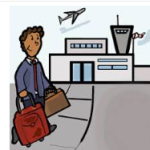

El avión El señor El avión
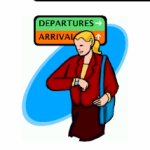

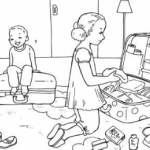
La señora La auxiliar de vuelo Los niños
ACTIVIDAD # 3
Describir. Look at the following picture and, with a partner, describe what people are doing (use present progressive).
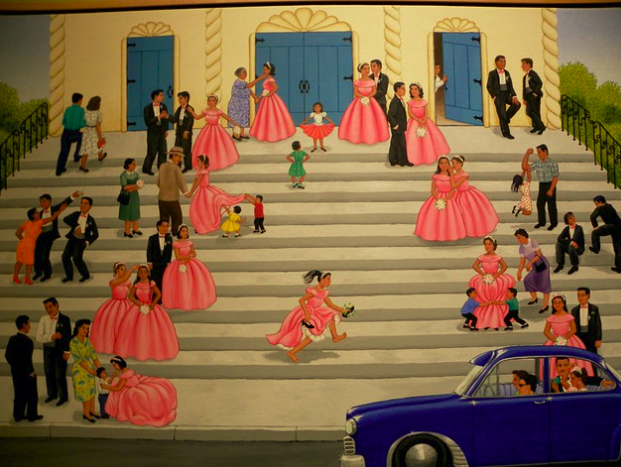
Quinceañera, 2001 (Carmen Lomas Garza)
- La quinceañera (young woman in the car)
- Las dos niñas delante de la puerta
- La pareja a la izquierda (the couple)
- La niña y su papá
- Los dos chicos al lado de la puerta
- La chica en el medio de la pintura
ACTIVIDAD # 4
¿Qué estás haciendo. . .? With a partner, take turns asking and answering what you are doing at the following times.
Ejemplo: 8 am.
E1: ¿Qué estás haciendo a las ocho de la mañana?
E2: A las ocho estoy desayunando / estoy durmiendo / haciendo ejercicio
- 9:30 am.
- 12:30 pm.
- 5:00 pm.
- 9:00 pm.
- 11:30 pm.
ACTIVIDAD # 5
¡Hablemos! With a partner, take turns asking and answering the following questions:
ESTUDIANTE A
1. ¿Qué programa de televisión estás viendo?
2. ¿Estás tomando una clase de matemáticas este semestre?
3. ¿Estás trabajando este semestre? ¿Dónde?
4. ¿Qué libro estás leyendo?
5. ¿Qué estás haciendo ahora?
ESTUDIANTE B
1.¿Dónde estás viviendo?
2. ¿Estás estudiando francés este semestre?
3. ¿Con quién estás hablando en este momento?
4. ¿Qué programa de televisión estás viendo?
5. ¿Estás trabajando este semestre? ¿Dónde?
5.3 Gramática: SER vs. ESTAR (To be or not to be. . . )
A. USES OF SER. To help you remember the uses of the verb SER use the following acronym.
D.O.C.T.O.R.E
Date/ day
Origin/Nationality
Characteristic / description
Time
Occupation / Profession
Relationships/Ownership
Event
Ejemplos:
- Date/ day: It is used to express the date and days of the week.
Hoy es el primero de abril. Today is April 1st.
Mañana es jueves. Tomorrow is Thursday. - Origin/Nationality: Indicates origin and describes nationalities.
Ella es de Perú. She is from Peru.
Ella es peruana. She is Peruvian. - Characteristics: Describes essential qualities.
Ella es inteligente. She is smart.
Ellos son simpáticos. They are nice. - Time: is used to express time.
El vuelo es a las siete de la noche. The flight is at 7pm.
Son las cinco y media de la tarde. It is five-thirty in the afternoon. - Occupation/Profession: Describes professions or trades.
Ella es auxiliar de vuelo. She is a flight attendant.
Yo soy enfermera. I am a nurse. - Relationships/Ownership: indicates relationships and ownership.
Gloria es mi sobrina. Gloria is my niece.
Estas son mis maletas. These are my suitcases. - Event: Indicates where an event is taking place.
La fiesta es en mi casa. The party is at my house.
B. USES OF ESTAR. To help you remember the uses of the verb ESTAR use the following acronym.
L.A.C.E. (“tion words”)
L ocation (things and people)
A ction
C ondition
E motion
- Location: expresses where places, people, or things are located:
Estoy en la clase de español I am in the Spanish class.
¿Dónde está el baño? Where is the bathroom?
- Action: expresses the progressive tenses (action in progress).
Estoy hablando con el doctor I am talking to the doctor.
¿Qué estás haciendo? What are you doing?
- Condition: expresses health and other changeable states.
¿Cómo estás? How are you?
Estoy muy enferma. I am very sick.
- Emotion: expresses emotions.
Estoy contenta hoy. I am happy today.
Ser and Estar with adjectives
There are some adjectives that change in meaning when used with SER and ESTAR.
ser aburrido to be boring estar aburrido to be bored
ser bueno to be good estar bueno to be tasty/attractive
ser cansado to be a tiring person estar cansado to be tired
ser listo to be clever estar listo to be ready
ser malo to be bad estar malo to be ill
ser orgulloso to be conceited or vain estar orgulloso to be proud
ser moreno to be dark-skinned estar moreno to be tanned
ser pesado to be heavy/to be boring estar pesado to be annoying
ser rico to be rich estar rico to be tasty
ser seguro to be confident estar seguro to be sure
ser verde to be green estar verde to be unripe
ser viejo to be old estar viejo to look old
ACTIVIDAD # 1
Selecciona. Choose the right form of the verb SER o ESTAR.
- Diego ( es, está ) de Madrid pero ahora ( es, está ) estudiando en California.
- El concierto ( es, está ) mañana. Los músicos ( son, están ) mexicanos.
- Yo no puedo tomar ese café porque ( es, está ) frío y la taza (cup) ( es, está ) sucia.
- Paco y Ana ( son, están ) novios. Ellos ( son, están ) muy enamorados.
- La boda (wedding) ( es, está ) en junio, en la iglesia que (es, está) en Phoenix.
- El coche nuevo ( es, está ) de Luis (es, está ) un BMW, ¿verdad?
- Mi hermana ( es, está ) hipocondriaca. Siempre (es , está) enferma.
- ¿Qué hora ( es, está )? No sé. Mi reloj ( es , está ) roto (broken).
- Tú y yo ( somos, estamos ) nerviosos porque los exámenes ( son , están ) difíciles.
- Nunca ( soy, estoy ) aburrida en clase porque el profesor ( es , está ) dinámico.
¡Inténtalo!
ACTIVIDAD # 2
¿SER o ESTAR? Decide if ser or estar verb is appropriate for each sentence, then conjugate to fill the blank and complete the sentence.
- ¿_______tú de los Estados Unidos?
- Yo ______ puertorriqueña.
- Mi teléfono ______ en mi mochila.
- Mi mamá ____ enfermera (nurse) en un hospital y siempre _____ muy cansada.
- Disculpe, ¿Dónde _____la estación de tren?
- Yo _____ muy contento porque entiendo la diferencia entre Ser y Estar.
¡Inténtalo!
ACTIVIDAD # 3
Preguntas personales. Answer the following personal questions using ser and estar.
- ¿Cómo estás hoy?
- ¿Cómo eres?
- ¿Eres reservado(a) o extrovertido(a)?
- ¿Estás muy ocupado(a) en este momento?
- ¿De dónde es tu familia?
- ¿Dónde estás ahora (now)?
ACTIVIDAD # 4 Pair-Share
Traducción. Using the verbs SER or ESTAR. Translate the following paragraph into Spanish.
How would you describe Alberto to a Spanish-speaking friend?
Alberto is a handsome young man. He’s not an American; he is from Chile, but now he’s in Tempe. His father is a professor, and his mother is a doctor. He’s not married, but he has a girlfriend. Alberto studies at Arizona State University, and he likes his classes. Today he’s at home (en casa) because he is very sick. He is probably very bored, and he is watching TV or talking on the phone with his girlfriend.
ACTIVIDAD # 5
Pasatiempos. Con un compañero describan las personas en estas imágenes. The descriptions should respond to the following questions (be creative!):
| ¿Quiénes son?
¿Dónde están? ¿Qué están haciendo? ¿Cómo están? (cómo se sienten) |
¿De dónde son?
¿Cuál es su profesión? ¿Quién está de vacaciones? ¿Qué tiempo hace? |
|---|
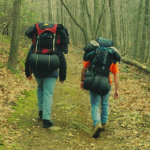

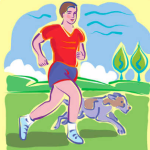
1 2 3
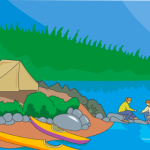


4 5 6
ACTIVIDAD # 6
¿Quién soy? Using the verbs SER and ESTAR, share the following information about yourself.
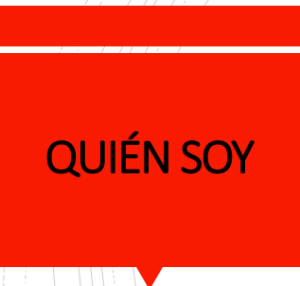 |
|
|---|
Cultura: Puerto Rico

Capital: San Juan Other important cities:
Interesting to know:
|
|---|
Música: Marc Anthony
Canción: Vivir mi vida
|
Voy a reír, voy a bailar A veces llega la lluvia Coro Voy a reír, voy a bailar ¡Eso! Coro ¡Mi gente! ¡Toma! Siente y baila y goza La vida es una Coro |
|---|
Personalidad: Lin-Manuel Miranda

|
Press play to listen to the pronunciation of the reading in the paragraph written below. Lin-Manuel Miranda (16 de enero de 1980) es de Nueva York (Nuyorican), pero su familia es de Puerto Rico. Lin-Manuel es dramaturgo, compositor y actor. Él es el creador y el protagonista de los musicales de Broadway In the Heights (2008) y Hamilton (2016). El musical Hamilton ganó (won) el premio Pulitzer y 11 premios Tony. Además de teatro, su carrera incluye numerosos trabajos para televisión y cine. Participó (participated) en series como Los Sopranos (1999), Sex and the City (1998), House (2004) y The Electric Company (2006). Miranda también es reconocido por su trabajo en los soundtracks de Moana (2016) y Star Wars: The Rise of Skywalker (2019). |
|---|
Preguntas de Comprensión. After reading the short biography of Lin-Manuel Miranda, answer the following questions.
1.¿Cuál es la nacionalidad de Lin-Manuel Miranda?
____________________________________.
2. ¿Cuántos premios ganó el musical Hamilton?
____________________________________.
3. ¿Nombra dos (2) series de televisión donde participó (participated) Miranda?
____________________________________.
4. ¿Te gustan los musicales de Broadway?
____________________________________.
Lectura: Lugares favoritos para visitar
Press play to listen to the pronunciation of the reading in the paragraph written below.
Destinos turísticos de América Latina
América Latina ofrece una gran variedad de destinos turísticos: playas, pirámides, sitios prehispánicos, ciudades coloniales y modernas. Hoy en día más turistas visitan países de habla hispana para conocer más de las tradiciones y practicar el español, que es uno de los idiomas más populares en el mundo. Además, la gastronomía latinoamericana es abundante y muy variada.
Los lugares más visitados son Argentina, México, Perú y Ecuador porque existen atracciones muy importantes para visitar como las islas Galápagos, las pirámides de Teotihuacán y Machu Picchu. Sin embargo, el país más visitado por los turistas continúa siendo México, con más de 30 millones de turistas extranjeros por año. Para el año 2021, otros países de Hispanoamérica van a estar en la lista como los más visitados, entre ellos: Colombia y Chile. Estos países son preferidos por los turistas por varias razones: su diversidad, su increíble paisaje y, especialmente, su gente.
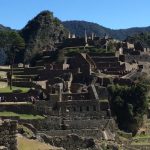
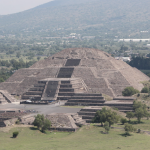
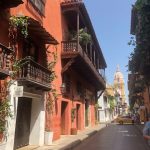
Machu Picchu Pirámides de Teotihuacán Cartagena
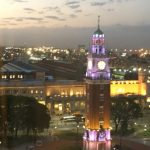
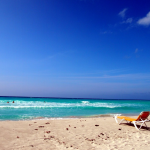
Buenos Aires Playa Varadero
ACTIVIDAD # 1
Preguntas de comprensión. Based on the reading, answer the following questions in complete sentences.
- ¿Por qué los turistas quieren visitar los países de América Latina?
- Menciona los 4 países más visitados (most visited).
- ¿Cuántas personas visitan México por año?
- ¿Qué lugares históricos podemos visitar en América Latina?
- ¿Qué país deseas visitar? ¿Por qué?
ACTIVIDAD # 2
Asociación. Asocia la atracción turística con el país:
- Machu Picchu _____ México
- Cartagena _____ Argentina
- Teotihuacán _____ Perú
- Varadero _____ Colombia
- Buenos Aires _____ Cuba

